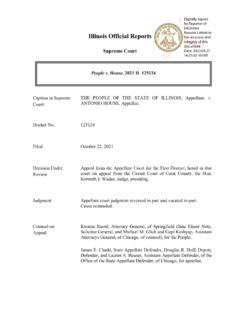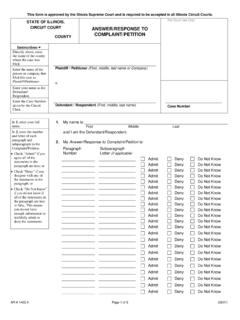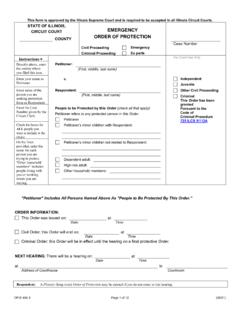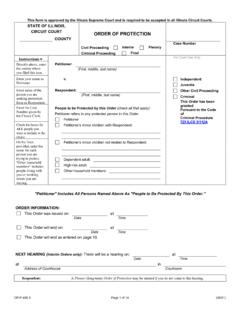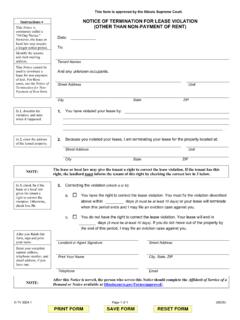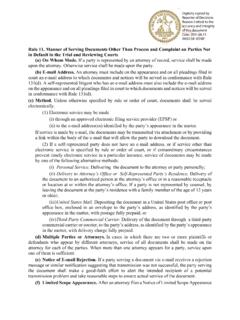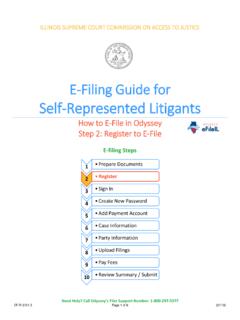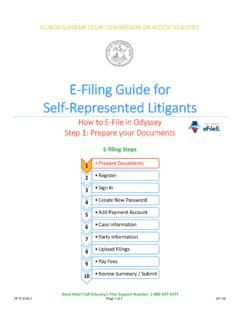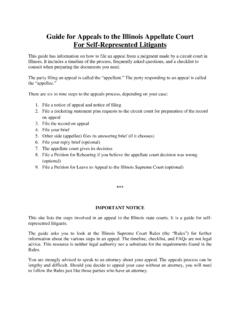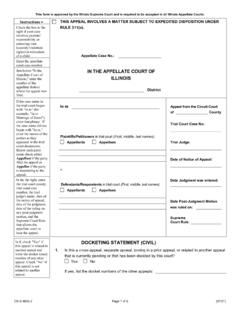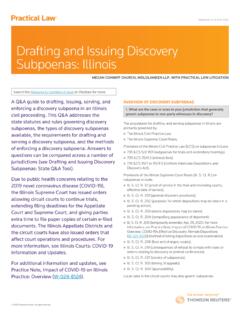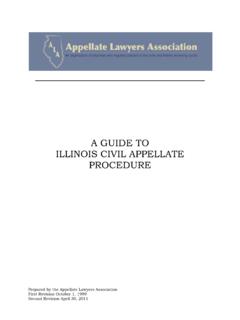Transcription of RULES OF THE ILLINOIS APPELLATE COURT, FIRST DISTRICT
1 1 RULES OF THE ILLINOIS APPELLATE court , FIRST DISTRICT Adopted May 5, 2021 Preamble. The APPELLATE court of ILLINOIS , FIRST DISTRICT , adopts these RULES pursuant to ILLINOIS Supreme court Rule 22(h). Proceedings in this court are primarily governed by the ILLINOIS Supreme court RULES , and, in particular, by ILLINOIS Supreme court RULES 301 through 375 and 601 through 633. These RULES supplement, but do not replace, the ILLINOIS Supreme court RULES and any applicable laws. As used in these RULES , (1) court shall include each division, unless the context indicates otherwise; (2) clerk means the Clerk of the APPELLATE court , FIRST DISTRICT ; (3) Supreme court Rule(s) means the ILLINOIS Supreme court Rule(s); (4) the term circuit court shall include an administrative agency whose decision has been directly appealed to this court ; and (5) the term clerk of the circuit court shall include the keeper of the records of an administrative agency whose decision has been directly appealed to this court .
2 Rule 1. Organization. (a) Divisions. The court sits in divisions as determined by the ILLINOIS Supreme court . Each year, each division shall elect a presiding judge and a member of the Executive Committee from among its members to serve a term of one year beginning on September 1. A division may replace an officer during that term. At the same time, each division shall also recommend one of its members to the Executive Committee to serve as a member of the Mediation Committee, whom the Executive Committee shall appoint, unless good cause is s hown. (b) Executive Committee.
3 The Executive Committee shall consist of one judge from each division, elected by the judges of the division for a term of one year. The Executive Committee shall exercise general administrative authority over the court . (c) Officers of the Executive Committee. The Executive Committee shall elect a chair and vice-chair to serve for a term of one year beginning on September 1 of each year. The vice-chair may act in place of the chair when the chair is unavailable. (d) Sessions. The court shall be in session continuously throughout the year. Each division shall sit as frequently as business requires.
4 (e) Decisions. Three judges must participate in the disposition of every case, and the concurrence of two judges is necessary for a disposition. (f) Motions. One judge may decide any motion of course. (g) Scheduling. Each division may sit for oral arguments on the dates and times set by the Executive Committee. The division may set oral arguments at different times, subject t o availability of the courtroom and the general authority of the Executive Committee. Oral arguments may be conducted by telephone or video conferencing as provided by Supreme court Rule 45.
5 2 Rule 2. Assignment of Cases. (a) Ready Cases. When a case becomes ready, (1) the Director of Research shall review the case to determine if it should be assigned to the Research Department (except for cases placed on an accelerated docket), and (2) the case shall be randomly assigned by electronic process to an authoring judge and a panel of two additional judges from the authoring judge s division. Random assignment of cases shall be balanced for an annual equalization among judges. If the authoring judge fails to secure a majority of the panel for any reason (either as to the judgment or the rationale), the presiding judge (if the presiding judge is in the majority) or, otherwise, the senior judge in the majority shall reassign a new author from among the judges in the majority.
6 If the authoring judge recuses himself or herself, the chair of the Executive Committee shall authorize the case to be randomly reassigned by electronic process. The assigned panel shall render the dispositional order of the court , except (a) for realignment due to recusals and division rotation; (b) by order of the chair of the Executive Committee; and (c) where the authoring judge determines that (i) there is a need to promptly dispose of an accelerated or expedited case; (ii) where an assigned member of the panel is unavailable due to recusal, illness, or vacation; or (iii) adherence to panel designations would unduly delay the disposition of a case.
7 (b) Non-Ready Cases. The clerk shall randomly assign non-ready cases by electronic process to one of the six divisions for motion purposes. Except for transfers due to consolidations, recusals, or related case purposes, this assignment shall remain fixed until the case becomes ready, regardless of the annual rotation or reassignment of any judge to a different division. A staff motions attorney designated by the court shall examine the notice of appeal and the docketing statement of each new appeal filed. If this review demonstrates there is a question regarding whether this court has jurisdiction over the appeal, the attorney shall notify the chair of the Executive Committee.
8 If the chair agrees with the staff attorney s assessment, the appellant shall be ordered to file a jurisdictional statement. (c) Related Cases. The clerk shall assign a case that is related to a prior case assigned to an authoring judge who is still a member of this court to that judge as the authoring judge and to a panel of judges from the authoring judge s division. If the authoring judge is no longer a member of the court , any case related to the disposed case shall be assigned as any other case. Examples of related cases include, but are not limited to: (1) A postconviction appeal and the direct appeal of a criminal case; (2) An appeal at the conclusion of a case and a prior interlocutory appeal; (3) A section 2-1401 appeal and the direct appeal; 3 (4) An appeal from the same circuit court number, or the successor circuit court number, as in a prior case; (5) Cases that arise out of the same incident regardless of whether they share the same circuit court number.
9 And (6) Cases that involve similar issues where one or more of the parties are the same. The clerk shall assign cases listed in categories ( c)(5) and ( c)(6) as related only with permission of the chair of the Executive Committee. The chair of the Executive Committee may also assign cases as related in the interest of judicial economy. (d) Assignment of Related or Consolidated Cases. When a ready case is consolidated with a non-ready case, or a ready case is designated as related to a non-ready case, the cases may, in the chair s discretion, be assigned to the authoring judge and panel of the ready case.
10 When non-ready cases are consolidated or designated as related, they shall be assigned for motion purposes to the division of the lowest-numbered case. Consolidation orders shall specify the due date for the next forthcoming required filing, if any, and should strike any inconsistent filing deadlines. (e) Authority of the Executive Committee. The Executive Committee may, in its discretion, transfer or reassign any case to a new authoring judge or division by randomized computer process. Rule 3. Processing of New Cases. (a) New Cases. When the clerk receives (1) the transmittal of a notice of appeal, a notice of interlocutory appeal, or a filing for a case not already assigned a docket number; (2) a motion for leave to file a late notice of appeal; (3) a petition for leave to appeal; (4) a Rule 308 application; (5) a Rule 604(c) bail motion; or (6) a Rule 335 petition for review, the clerk shall assign the case a permanent consecutive number and enter the case on the docket, regardless of whether the filing otherwise complies with applicable court RULES .
